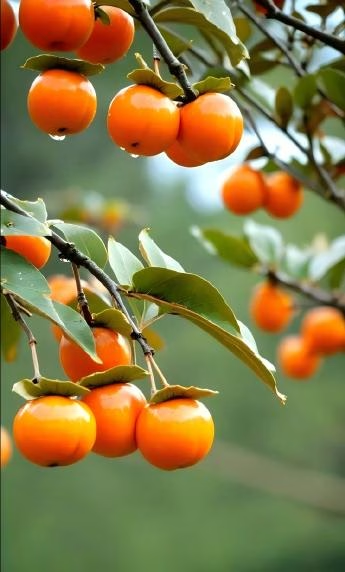Persimmons are beneficial for the intestines, but what precautions should be taken when eating them? How should you choose?
Juicy and smooth versus sweet and crisp: which autumn persimmon do you prefer? Persimmons are rich in pectin, a water-soluble dietary fiber. They have a laxative effect, helping to relieve hemorrhoids and constipation. They are also beneficial for maintaining normal intestinal flora.
Avoid eating persimmons on an empty stomach
Try to avoid eating persimmons on an empty stomach or eating them with high-protein foods such as fish, shrimp, and crab to prevent the formation of “persimmon stones” and constipation.
Persimmon Types
Persimmons are in season from August to November. Common persimmon varieties can be roughly divided into sweet and astringent types, depending on whether the fruit naturally loses its astringency on the tree after ripening.
- Sweet Persimmons
They can be eaten immediately after harvest. Common varieties include Jiro, Hanagosho, and Fuyou. Fuyou is the most cultivated variety, offering a crisp, sweet flavor that can be enjoyed until the end of the year.
- Astringent Persimmons
After harvesting, they must be de-astringent before being eaten fresh or processed into dried persimmon cakes. Persimmons are available for four weeks starting in late August, making them the earliest member of the persimmon family to be in season.
Five Tips for Choosing Delicious Persimmons
- Fruit Weight: Fruits are graded based on weight, with heavier fruits commanding higher prices.
- Fruit Shape: Fruits should be uniform and full, exhibiting a unique variety shape. For example, the Fuyu variety has an oblate shape, while the Jiro variety has an oblate square shape.
- Fruit Appearance: The skin should be smooth, free of dents, bruises, blemishes, cracks, water stains, or scars. There should also be no calyx cracks or cracked fruit bases.
- Fruit Color: The skin should be an even, smooth orange-red color.
- Flesh Appearance: The flesh should be a vibrant orange-red with few brown spots. Flesh Taste: The flesh should be fine-textured, sweet, crisp, and fresh, with a rich flavor and no astringency.
Three things to keep in mind when eating persimmons
Persimmons contain dietary fiber, vitamin A, potassium, calcium, carotene, sugar, protein, iron, and iodine. The astringency of persimmons primarily comes from the soluble tannins in the fruit. Sweet persimmons lack astringency because soluble tannins are converted into insoluble tannins, resulting in a less astringent taste.
Three things to keep in mind when eating persimmons:
Remember to remove the skin of persimmons to reduce tannins and tannins, which also minimizes gastrointestinal irritation.
Patients with chronic renal failure or those undergoing dialysis should avoid consuming excessive amounts of persimmons, as they are rich in phosphorus and potassium, which can put a strain on their metabolism.
High-quality persimmons have a sugar content of over 15 degrees. Diabetics should monitor their intake and avoid excessive sugar intake.


Leave a Reply